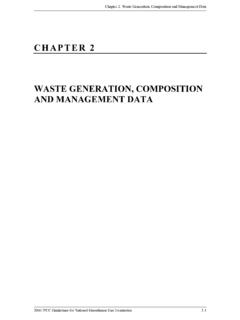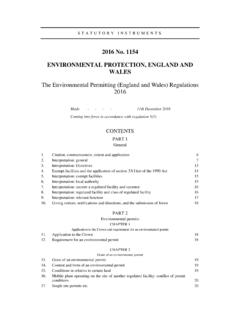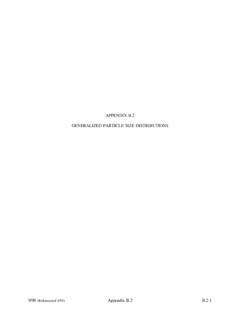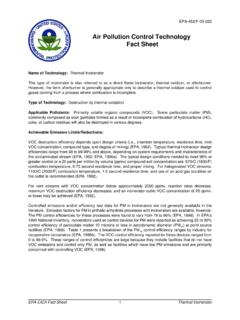Transcription of ENVIRONMENTAL IMPACTS OF THE OIL INDUSTRY
1 PETROLEUM ENGINEERING DOWNSTREAM - ENVIRONMENTAL IMPACTS Of The Oil INDUSTRY - Jacqueline Barboza Mariano, Emilio L bre La Rovere ENVIRONMENTAL IMPACTS OF THE OIL INDUSTRY . Jacqueline Barboza Mariano Energy Specialist at National Petroleum Agency of Brazil Emilio L bre La Rovere Professor at Energy Planning Program, Federal University of Rio de Janeiro, Brazil Keywords: ENVIRONMENTAL IMPACTS , Exploration, Production, Refining, Oil, Natural Gas. Contents 1. Introduction S. TE S. 2. Oil and Gas Production Activities and ENVIRONMENTAL Issues 3. Petroleum Refining Activities and ENVIRONMENTAL Issues R. AP LS. Air Emissions Water Effluents Solid Wastes C EO. 4. ENVIRONMENTAL Risks of the Oil INDUSTRY 5.
2 Conclusions and Recommendations Related Chapters Glossary Bibliography E . H. Biographical Sketch PL O. Summary M SC. This chapter aims to present the main ENVIRONMENTAL IMPACTS of the oil and gas INDUSTRY throughout the stages of exploration and discovery of new deposits, hydrocarbon production and oil refining. It also addresses the issue of ENVIRONMENTAL risks in the SA NE. INDUSTRY and possible accidents that may arise from its activities. 1. Introduction U. Oil plays a vast and vital role in our society as it is organized today. Oil represents much more than just one of the main energy sources used by mankind. Besides being an important energy source, petroleum products serve as feedstock for several consumer goods, thus playing a growing and relevant role in people's lives.
3 On the other hand, the oil INDUSTRY holds a major potential of hazards for the environment, and may impact it at different levels: air, water, soil, and consequently all living beings on our planet. Within this context, the most widespread and dangerous consequence of oil and gas INDUSTRY activities is pollution. Pollution is associated with virtually all activities throughout all stages of oil and gas production, from exploratory activities to refining. Wastewaters, gas emissions, solid waste and aerosols generated during drilling, production, refining (responsible for the most pollution) and Encyclopedia of Life Support Systems (EOLSS) PETROLEUM ENGINEERING DOWNSTREAM - ENVIRONMENTAL IMPACTS Of The Oil INDUSTRY - Jacqueline Barboza Mariano, Emilio L bre La Rovere transportation amount to over 800 different chemicals, among which, of course, prevail oil and petroleum products.
4 Other ENVIRONMENTAL IMPACTS include intensification of the greenhouse effect, acid rain, poorer water quality, groundwater contamination, among others. The oil and gas INDUSTRY may also contribute to biodiversity loss as well as to the destruction of ecosystems that, in some cases, may be unique. Most potential ENVIRONMENTAL IMPACTS related to oil and gas INDUSTRY activities are already well documented. It is still necessary to find ways to conciliate INDUSTRY development with ENVIRONMENTAL protection, that is, with sustainable development. After recovered and transported, crude oil has to go through refining processes in order to be converted into products that hold commercial value.
5 Oil refineries are major polluters, consuming large amounts of energy and water, producing large quantities of S. TE S. wastewaters, releasing hazardous gases into the atmosphere and generating solid waste that are difficult both to treat and to dispose of. R. AP LS. On the other hand, despite its potential threats to the environment, the oil INDUSTRY plays a positive role in society as well, creating many jobs and generating a significant C EO. volume of tax revenues and royalties to national governments. Therefore, oil companies may profit even more and in different ways by adopting proactive ENVIRONMENTAL strategies. However, many companies in the oil business are still not adopting pollution prevention practices.
6 Their ENVIRONMENTAL policies are E . oriented towards the compliance of rules established by ENVIRONMENTAL authorities, H. which reflects an End of Line Control corporate culture as well as a reactive approach to PL O. ENVIRONMENTAL management. Taking the ENVIRONMENTAL variable into account in productive processes has been a M SC. serious and important challenge for the oil INDUSTRY . Today, the commitment to promote sustainable development goes beyond ethical and moral obligations, and has become a demand from society. This commitment alone is a limiting factor to the survival of SA NE. companies, since numerous consumers may be influenced by the negative image associated with companies that harm the environment.
7 Table 1 presents in a simplified manner the main potential ENVIRONMENTAL IMPACTS of the U. oil INDUSTRY , as well as some feasible alleviating measures. Potential ENVIRONMENTAL IMPACTS Mitigation Measures Water contamination due to effluent, No wastewaters shall be discharged wash water and cooling water discharges, without appropriate treatment into rivers and seepage from storage and waste or other locations where infiltration may tanks; occur. Water contamination due to discharges of Water effluents may be treated by: water effluents rich in inorganic salts neutralization, evaporation, aeration, without appropriate treatment (saline flocculation, oil and grease separation, pollution) carbon adsorption, reverse osmosis, ion Encyclopedia of Life Support Systems (EOLSS) PETROLEUM ENGINEERING DOWNSTREAM - ENVIRONMENTAL IMPACTS Of The Oil INDUSTRY - Jacqueline Barboza Mariano, Emilio L bre La Rovere Thermal pollution due to discharge of exchange, biotreating etc.
8 , depending on effluents with temperatures higher than the contaminant to be removed. recipient water bodies; Liquid effluent discharges into recipient Water contamination due to oil spills; water bodies must comply with standards governed by laws and regulations adopted in each country. Materials that may seep due to rains must be placed in covered storage areas equipped with drainage systems, in order to avoid contamination of rain waters. Areas for storing and handling of raw materials and products should be waterproofed and have a drainage system, so that any spills and wash waters can be directed to treatments. S. TE S. Particulate emissions into the atmosphere Particulate emissions can be controlled generated during operations at production by equipment such as cyclones, bag R.
9 AP LS. and refining plants. filters, electrostatic precipitators and scrubbers, among others;. C EO Acidic emissions such as sulfur and nitrogen oxides can be controlled with the use of wet scrubbers;. Dust emissions from patios and outdoor areas free from chemical contaminants can be controlled with water sprays. E . Sulfur and nitrogen oxides, ammonia, Gas emissions can be controlled by wet H. acid mist and fluorine compounds gas scrubbers or carbon adsorption, among emissions from production and refining other techniques. PL O. plants operations. Occasional release of potentially Preventive maintenance of equipment and M SC. hazardous materials, such as solvents and storage areas, to prevent occasional leaks.
10 Acid or alkaline materials. Dikes and catch basins placed around or downstream from dangerous or environmentally hazardous materials SA NE. storage tanks. Soil, surface water and/or groundwater Solid wastes that cannot be recycled must contamination by inappropriate disposal be treated appropriately before final U. of solid wastes resulting from chemical disposal. INDUSTRY processes, including effluent The choice of appropriate treatment must treatment sludge and particulate matter comply with the waste classification from dust collectors. according to the pertinent regulation(s). Depending on the nature of the waste , possible treatment methods include: incineration, controlled landfill disposal, chemical immobilization and solidification, encapsulation, burning in cement kilns, etc.















